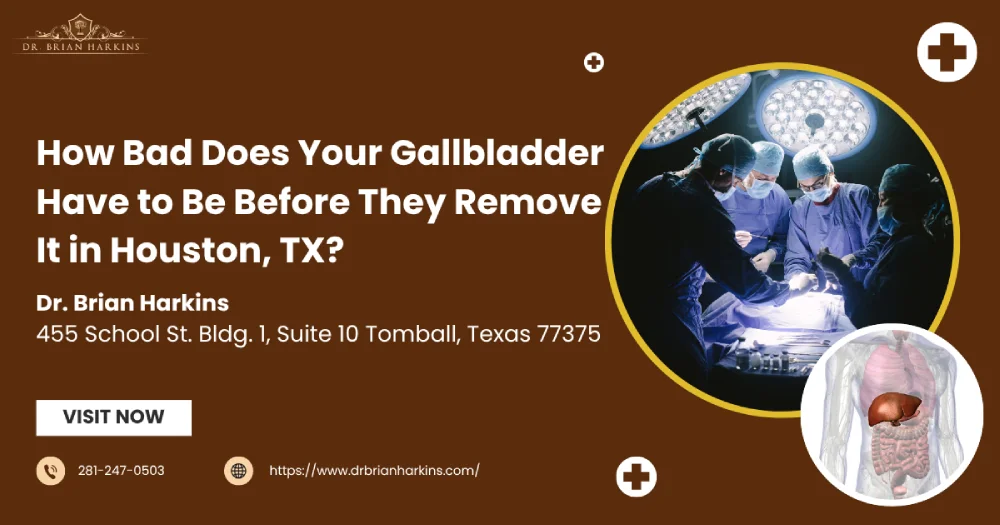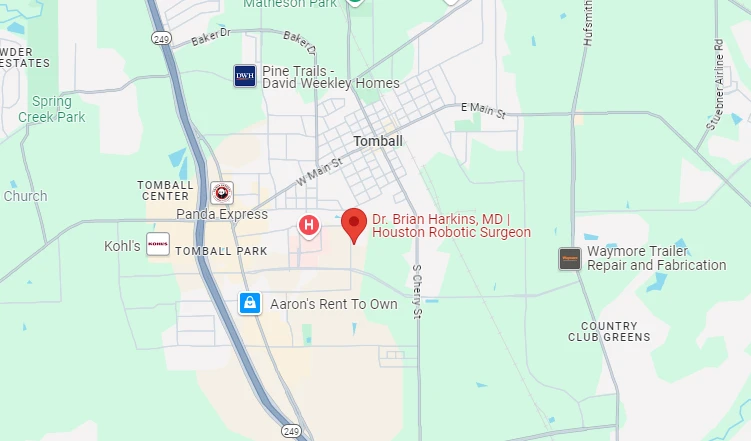
In Houston, TX, gallbladder removal—technically called cholecystectomy—is advised when gallbladder disease advances from nuisance to health threat. Local surgeons weigh the frequency of gallstone attacks, the presence of infection, and the danger of life-threatening complications before scheduling surgery to remove your gallbladder. If you need clear answers about your own gallbladder problems, keep reading. This guide explains the tipping point for surgical removal of the gallbladder, how doctors grade severity, and how minimally invasive care means less pain and quicker recovery for most Texans.
The gallbladder is a small pear-shaped sac that stores bile produced by the liver. When you eat, it squeezes bile through the common bile duct into the small intestine, helping you digest food rich in fat. Trouble starts when cholesterol or pigment in the bile crystallizes into stones, or when the organ’s muscular wall becomes inflamed. Left untreated, gallbladder inflammation can spread to the liver and pancreas, producing serious complications.
Classic signs and symptoms include abdominal pain in the upper right abdomen, nausea, and bloating after fatty meals. The discomfort often radiates to the back or shoulder. If pain lasts longer than four hours or wakes you at night, you’ve moved beyond “annoying” to “call the office now.”
| Severity | Common Symptoms | Imaging Findings | Usual Houston Treatment |
|---|---|---|---|
| Mild (1–3) | Indigestion, brief pain | Sludge, tiny stones | Diet, watchful waiting, treat gallbladder flare-ups |
| Moderate (4–6) | Recurrent biliary colic | Multiple stones, thick wall | Elective gallbladder surgery |
| Severe (7–10) | Fever, jaundice, vomiting | Blocked duct, pancreatitis | Urgent or emergency surgery to remove the gallbladder |
Before you make an appointment with a gastroenterologist or surgeon, gather details about your pain pattern. Houston specialists combine history, lab work, and imaging to form a diagnosis of gallbladder trouble.
If tests confirm stones, infection, or untreated gallbladder disease that threatens other organs, your doctor may state bluntly: “You need surgery.” Waiting risks a life-threatening rupture, abscess, or pancreatitis. The good news? Houston offers advanced laparoscopic procedures that remove the organ through small incisions in your abdomen, resulting in less pain and faster healing.
Laparoscopic cholecystectomy is the dominant minimally invasive surgical option. A tiny camera called a laparoscope goes through one incision; instruments are inserted through the other incisions to clip and divide the cystic duct and artery. Rarely, dense scarring or bleeding forces open surgery.
Your liver keeps making bile from the liver; it now trickles directly into the intestine. Some people notice looser stools after heavy meals, but fiber supplements usually help. Most patients report less pain, better sleep, and renewed energy once the inflamed organ is gone.
Residents from downtown Houston to Sugar Land can book an appointment online with Dr. Harkins to discuss whether they need gallbladder removal. Call the office if you’re experiencing persistent pain in the upper right abdomen or jaundice.
Short delays are possible if attacks are mild and no infection is present, but your doctor may caution against waiting more than a few weeks. Untreated gallbladder disease can flare unexpectedly, leading to emergency surgery and longer downtime than planned.
A low-fat, high-fiber diet may reduce symptoms but rarely dissolves established stones. Medical dissolution with ursodiol works only on small cholesterol stones and takes months. If you keep having attacks, surgery remains the most reliable cure.
The technique uses a camera and slender tools through four incisions each smaller than a dime. Less muscle is cut, so patients feel less pain, require fewer narcotics, and often return to activity faster than with open surgery.
Most people digest food normally after healing. A minority notice looser stools after very fatty meals, especially in the first three months. Gradual re-introduction of fats and adding soluble fiber usually resolves the issue.
Not always. While 75 % of stones are cholesterol based, the rest derive from bilirubin (pigment stones) or mixed causes such as infection. Even people with normal blood cholesterol can develop stones if bile chemistry is imbalanced.
Routine cholecystectomy patients do not require long-term blood thinners. However, if you already take anticoagulants for heart or vascular disease, your surgeon will coordinate with your cardiologist on peri-operative management.
Most patients can drive in three to five days, provided they are off prescription pain medication and can twist comfortably without hesitation. Always test your reaction time in a safe area before getting on busy Houston highways.
Yes, upper abdominal pain overlaps with ulcers, reflux, and even cardiac conditions. That’s why thorough evaluation—including labs, imaging, and sometimes endoscopy—is essential to confirm the diagnosis of gallbladder disease and rule out other disorders.
Surgery risk depends more on overall health than age alone. Healthy adults in their 80s often do well with laparoscopic removal, while younger patients with heart or lung disease may need extra precautions. Pre-operative assessment tailors the plan to you.
Stones cannot form in an organ that’s gone; however, rare “retained duct stones” can appear months later if a fragment is missed. These are typically resolved with ERCP, not repeat abdominal surgery.


Dr. Brian Harkins is a renowned surgeon specializing in advanced, minimally invasive, and robotic surgical techniques. With a dedication to innovation and personalized patient care, he has transformed countless lives by delivering exceptional outcomes.

I want a website like this, where do i start?